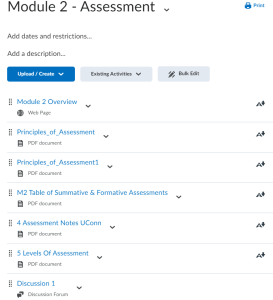13 HyFlex Module Overview
Learning Objectives
- Apply the HyFlex Design concepts to create the first three modules of the HyFlex pilot course.
- Select and share a topic for a Model Practice on HyFlex Teaching
This module covers topics such as content chunking, assessment options, and active learning principles in student engagement. It will also emphasize aspects of course load calculation and content accessibility.
Organizing content in modules, weeks, and topics
It is advisable to structure the content of the course into three types of modules: Start Here (or Welcome) Module, Topical or Weekly Modules, and Optional Resource Module.
The Start Here Module
The Start Here module orients students to the course instructor, syllabus, schedule, and any course resources they need to access. It provides students with communication expectations and links to campus resources to support their success in college. This module is important because it helps students get their bearings and build confidence in navigating the course site. A course welcome module is an essential element of the HyFlex modality to help students feel connected and ready to get started.
What does a Welcome Module look like?
Welcome Modules will differ according to the preferences and personality of each instructor, but they generally contain the following pages:
- Instructor Welcome
- The Instructor Welcome page typically includes a short welcome written by the instructor to their students as well as salient biographical information about the instructor, including their research interests and personal goals as a teacher. Often instructors can begin to build rapport with students by sharing a few personal details about their favorite places for travel, their favorite foods, or any pets at home. A few details about life beyond the classroom can help to emphasize that the instructor is both approachable and willing to get to know students.
- Instructors can also create a short welcome video (5 minutes or less) to help students orient themselves to the learning experience ahead. For some excellent sample introductory videos, check out the following:
- Course Syllabus and Course Schedule
- Course Resource access instructions for LTI or publisher integration resources
Topical or Weekly Modules
A module template lays out the desired sequence of content, activities, and assignments. Consistency in module design is important so that students can predictably locate content, activities, and assessments so that the sequence and student workload for each module is clear. Dividing your course into units or modules creates a coherent and user-friendly pathway.
Instructors often use sub-modules to group collected content so that the module-level view isn’t too crowded or busy. Pages are great because they allow instructors to frame and link to content so that students have a stronger sense of direction and engagement.
Once you have a module template, you can copy it so that each week or unit follows the same structure.
Suggested Module Template
- Module 1 [Content Topic]
- HTML File: Module 1 Overview
- On this page, instructors can provide a short text introduction to the themes or concepts of the week. They can introduce an introductory question or image, or provide more context for the week’s goals.
- Instructors can also share learning objectives for this week or unit: What will students be able to do or to know after they complete the module?
- Ideally, the Overview Page will also provide reminders of the weekly work and links to the following sections of the module.
- [Sub module] Module 1 Course Materials
- Typically each module or unit will include required reading and required media to watch or listen to. It is very helpful to use the page structure to divide readings from media so that students can budget their time accordingly. It is also important to use the bulleted or numbered list feature so that students using screen reader software can easily track all completed content.
- It is super helpful to annotate readings and media elements. What do you want students to think about as they engage? Are there key words you want them to pay attention to?
- For any media you want students to view or listen to, please include the viewing time (Viewing time: 4 minutes 30 seconds). This helps students manage their available study time effectively.
- It’s a great idea to separate what is required from what is optional or intended for further study if students have time. Including a section
- [Submodule] Module 1 Discussion/Assignment
- After the Week 2 Overview and Week 2 Course Content pages, it’s a great idea to add any assignments or discussions required for the week.
- By adding assignments or discussions at the end of the module, they stand out as required tasks.
- If an assignment is due in a few weeks, it’s a great idea to add it early so that students can review the purpose, tasks, and criteria for success before the assignment is due.
- [HTML File] Module 1 Wrap Up
- A wrap-up page is an important tool for helping students bridge or transition between weeks or units. In this space, you help students prepare for the week ahead by summarizing what this week covered, offering a final reflection question, or synthesizing key points you don’t want them to miss.
- Usually, this page is pretty short and offers a statement of encouragement and support as students move on to the next module or unit.
- HTML File: Module 1 Overview
Optional Resources Module
This module may contain additional resources the instructor wants to share with students that provide detailed and extra information on the topic as aligned with learning objectives and assessments. These resources are not considered in the course load estimation and are intended for motivated students who want to go beyond what is required.
Screenshot of a Sample Module Template

